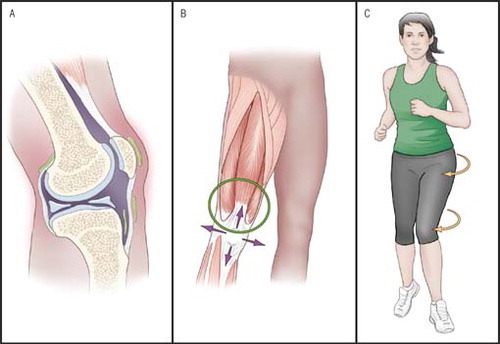Understand the Cause!
Pain in the front of your knee or under your kneecap is often called patellofemoral pain. The pain may be a nagging ache or an occasional sharp twinge, especially with stairs or walking downhill. Because the pain is around the front of your knee, treatment has traditionally focused on the knee itself. However, recent evidence suggests that strengthening your hip muscles can lessen the stress under the kneecap.
A study published in the January 2018 issue of JOSPT suggests strengthening your entire leg and outside of the hip can decrease your knee pain and help you return to full activity.

There is now evidence that stronger hip muscles can help lessen the stress under the kneecap, indicating that it is best to strengthen both the knee and hip muscles to avoid the movement shown here, which can cause knee pain.
Your Knee Pain Treatment Starts Here
We’ve included TWO videos to get you started. Strengthening the hip muscles aims to improve alignment and decrease anterior knee pain. You should notice the effort of the exercise is concentrated on the outside of your hip. That’s the key to this hip strengthening exercise.
Give these exercises a try 3-5 times a week for at least 6 weeks. If you have had moderate-to-severe patellofemoral pain for at least 3 months, this exercise approach may be beneficial to you. Your physical therapist can evaluate hip and knee muscle imbalances and build a customized care plan to keep you active for a lifetime.
Citation
J Orthop Sports Phys Ther 2018;48(1):32. doi:10.2519/jospt.2018.0501).
Nascimento et al, titled “Hip and Knee Strengthening Is More Effective Than Knee Strengthening Alone for Reducing Pain and Improving Activity in Individuals With Patellofemoral Pain: A Systematic Review With Meta-analysis” (J Orthop Sports Phys Ther 2018;48(1):19–31. doi:10.2519/jospt.2018.7365).
The information provided on this site is intended for your general knowledge only and is not a substitute for professional medical advice or treatment for specific medical conditions. You should not use this information to diagnose or treat a health problem or disease without consulting with Heather Lane Physical Therapy or another qualified healthcare provider.

